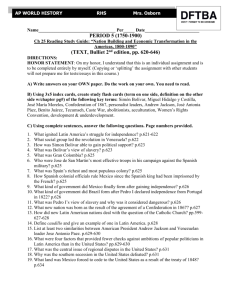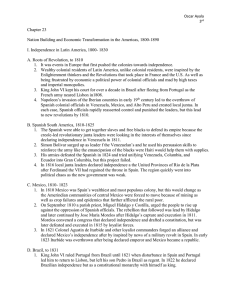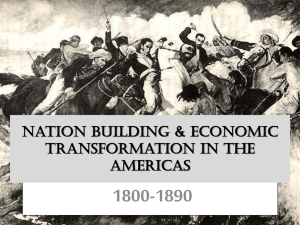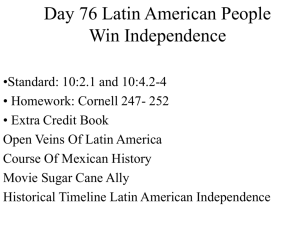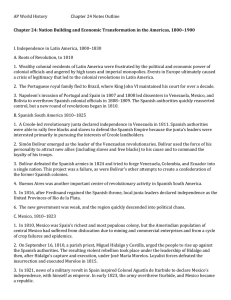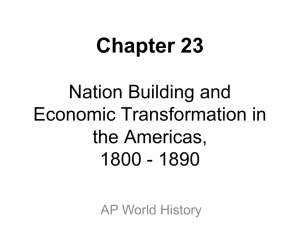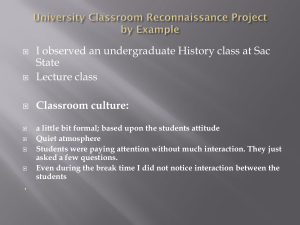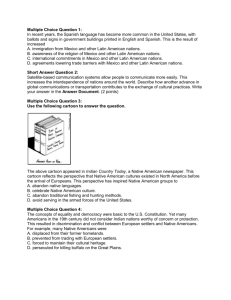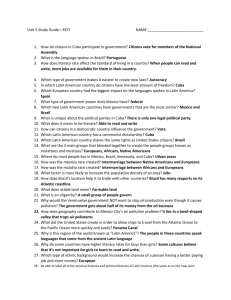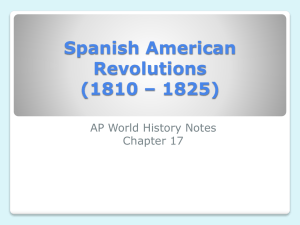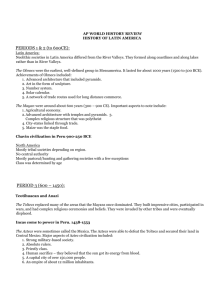Cht 23 PPT Nation Building & Economic Transformations in the
advertisement
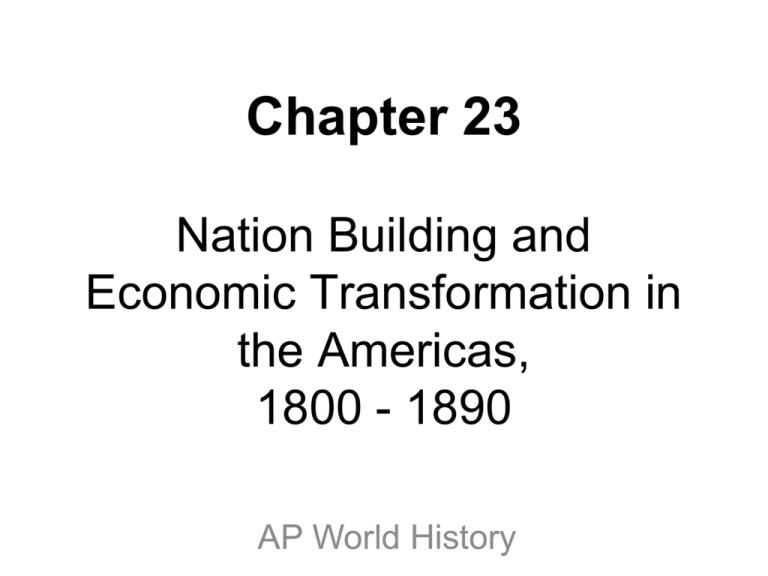
Chapter 23 Nation Building and Economic Transformation in the Americas, 1800 - 1890 AP World History I. Independence in Latin America, 1800–1830 A. Roots of Revolution, to 1810 • Wealthy colonial residents of Latin America were frustrated by the political and economic power of colonial officials and angered by high taxes and imperial monopolies. They were inspired by the Enlightenment thinkers and by the examples of the American and French Revolutions. • The Portuguese royal family fled to Brazil, where King John VI maintained his court for over a decade. • Napoleon’s invasion of Portugal and Spain in 1807 and 1808 led dissenters in Venezuela, Mexico, and Bolivia to overthrow Spanish colonial officials in 1808–1809. Add B. Spanish South America, 1810–1825 • A creole-led revolutionary junta declared independence in Venezuela in 1811. Spanish authorities were able to rally free blacks and slaves to defend the Spanish Empire because the junta’s leaders were interested primarily in pursuing the interests of creole landholders. • Simón Bolívar emerged as the leader of the Venezuelan revolutionaries. Bolívar used the force of his personality in order to attract new allies (including slaves and free blacks) to his cause and to command the loyalty of his troops. • In 1816, after Ferdinand regained the Spanish throne, local junta leaders declared independence as the United Provinces of Rio de la Plata. • The new government was weak and the region quickly descended into political chaos. C. Mexico, 1810–1823 • In 1810, Mexico was Spain’s richest and most populous colony, but the Amerindian population of central Mexico had suffered from dislocation due to mining and commercial enterprises and from a cycle of crop failures and epidemics. • On September 16, 1810 a parish priest, Miguel Hidalgo y Costilla urged the people to rise up against the Spanish authorities. The resulting violent rebellion took place under the leadership of Hidalgo and then, after Hidalgo’s capture and execution, under José María Morelos. • Loyalist forces defeated the insurrection and executed Morelos in 1815. • In 1821, news of a military revolt in Spain inspired Colonel Agustín de Iturbide to declare Mexico’s independence with himself as emperor. In early 1823 the army overthrew Iturbide and Mexico became a republic. D. Brazil, to 1831 • King John VI of Portugal ruled his kingdom from Brazil until 1821. • King John’s son Pedro remained in Brazil, where he ruled as regent until 1822, when he declared Brazil to be an independent constitutional monarchy with himself as king. • Pedro’s liberal policies (including opposition to slavery) alienated the political slave-holding elite, and he incurred heavy losses of men and money as he attempted to control Uruguay by military force. Street demonstrations and violence led Pedro I to abdicate in favor of his son, Pedro II, who reigned until republicans overthrew him in 1889. II. The Problem of Order, 1825–1890 A. Constitutional Experiments • Leaders in both the United States and in Latin America espoused constitutionalism. In the United States, the colonists’ prior experience with representative government contributed to the success of constitutionalism; in Latin America, inexperience with popular politics contributed to the failure of constitutions. • In Latin America, lack of experience with elected legislatures and municipal governments led the drafters of constitutions to experiment with untested and impractical political institutions. • Latin American nations also found it difficult to define the political role of the church and to subordinate the army and its prestigious leaders to civilian government. B. Personalist Leaders • Successful military leaders in both the United States and Latin America were able to use their military reputations as the foundations of political power. • The first constitutions of nearly all the American republics excluded large numbers of poor citizens from full political participation. This led to the rise of populist leaders who articulated the desires of the excluded poor and who at times used populist politics to undermine constitutional order and move toward dictatorship. • Andrew Jackson in the United States and José Antonio Páez in Venezuela are two examples of populist politicians who challenged the constitutional limits of their authority. • Personalist leaders like Páez and Jackson dominated national politics by identifying with the common people, but in practice, they promoted the interests of powerful property owners. C. The Threat of Regionalism • Central America split off from Mexico in 1823 and then broke up into five separate nations; Gran Colombia broke up into Venezuela, Colombia, and Ecuador; and Uruguay, Paraguay, and Bolivia declared their independence from Argentina. • Regionalism threatened the United States when the issue of slavery divided the nation, leading to the establishment of the Confederacy and the U.S. Civil War. • The Confederacy’s attempt to secede from the United States came when the national government was well-established and strengthened by experience, economic growth, and population growth. D. Foreign Interventions and Regional Wars • By the end of the nineteenth century, the United States, Brazil, Argentina, and Chile had successfully waged wars against their neighbors and established themselves as regional powers. • European military intervention included the British attack on the United States in the War of 1812, the United States’ war with Spain in 1898–1899, French and English naval blockades of Argentina, an English naval blockade of Brazil, and Spanish and French invasions of Mexico. When the French invaded Mexico in 1862 they ousted President Benito Juárez and established Maximilian Habsburg as emperor. Juárez drove the French out in 1867; Maximilian was captured and executed. • The United States defeated Mexico and forced the Mexican government to give up Texas, New Mexico, Arizona, and Colorado in 1848. • Chile defeated the combined forces of Peru and Bolivia in two wars (1836–1839 and 1879–1881). Argentina and Brazil fought over control of Uruguay in the 1820s, but finally recognized Uruguayan independence. Capture and burning of Washington by the British in 1814. E. Native Peoples and the Nation-State • Independent Amerindian peoples posed a significant challenge to the new nations of the Western Hemisphere, but Amerindian military resistance was overcome in both North and South America by the end of the 1880s. • In the United States, rapid expansion of white settlements between 1790 and 1810 led to conflict between the forces of the American government and Amerindian confederations like that led by Tecumseh and Prophet in 1811–181 • Further white settlement led to the Indian Removal Act of 1830. • Amerindians living on the Great Plains had become skilled users of horses and firearms, and thus offered more formidable resistance to the expansion of white settlement. • In Argentina and Chile native people were able to check the expansion of white settlement until the 1860s, when population increase, political stability, and military modernization gave the Chilean and Argentinean governments the upper hand. • In Mexico, plantation owners in the Yucatán Peninsula had forced Maya communities off their land and into poverty. III. The Challenge of Economic and Social Change A. The Abolition of Slavery • In the early nineteenth century slavery was weakened by abolition in some of the northern states of the United States, by the termination of the African slave trade to the United States (1808), and by the freeing of tens of thousands of slaves who joined the revolutionary armies in the Spanish American republics. • In the United States, abolitionists made moral and religious arguments against slavery. Two groups denied full citizenship rights under the Constitution, women and free African-Americans, played important roles in the abolition movement. • The Emancipation Proclamation ended slavery in the rebel states not occupied by the Union army, while final abolition was accomplished with the passage of the Thirteenth Amendment to the Constitution in 1865. • In Brazil, progress toward the abolition of slavery was slower and depended on pressure from the British. • In the Caribbean colonies there was little support for abolition among whites or among free blacks. Abolition in the British Caribbean colonies was the result of government decisions made in the context of the declining profitability of the sugar plantations of the British West Indies, while abolition in the French colonies followed the overthrow of the government of Louis Philippe. B. Immigration • As the slave trade ended, immigration from Europe and Asia increased. • Immigration brought economic benefits, but hostility to immigration mounted in many nations. Asian immigrants faced discrimination and violence in the United States, Canada, Peru, Mexico, and Cuba; immigrants from European countries also faced prejudice and discrimination. • The desire to sustain a common citizenship inspired a number of policies that aimed to compel immigrants to assimilate. C. American Cultures • Despite discrimination, immigrants altered the politics of many of the hemisphere’s nations as they sought to influence government policies. • Immigrants were changed by their experiences in their adopted nations, undergoing acculturation. D. Women’s Rights and the Struggle for Social Justice • In the second half of the nineteenth century women’s rights movements made slow progress. • Most working class women played no role in the women’s rights movements; nonetheless, economic circumstances forced working-class women to take jobs outside the home and thus to contribute to the transformation of gender relations. • Despite the abolition of slavery, various forms of discrimination against persons of African descent remained in place throughout the Western Hemisphere at the end of the century. E. Development and Underdevelopment • Nearly all the nations of the Western Hemisphere experienced economic growth during the nineteenth century, but the United States was the only one to industrialize. • Rising demand for mine products led to mining booms in the western United States, Mexico, and Chile. • Latin America, the United States, and Canada all participated in the increasingly integrated world market, but interdependence and competition produced deep structural differences among Western Hemisphere economies. • Cyclical swings in international markets partially explain why Canada and the United States achieved development while Latin America remained underdeveloped. Both the United States and Canada gained independence during periods of global economic expansion. Latin American countries gained independence during the 1820s, when the global economy was contracting. • Weak governments, political instability, and (in some cases) civil war also slowed Latin American development. Latin America became dependent on Britain and, later, on the United States for technology and capital. F. Altered Environments • Population growth, economic expansion, and the introduction of new plants and animals brought about deforestation, soil exhaustion, and erosion. Rapid urbanization put strain on water delivery systems and sewage and garbage disposal systems and led to the spread of the timber industry. • Faced with a choice between protecting the environment or achieving economic growth, all of the hemisphere’s nations chose economic growth.
